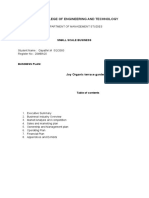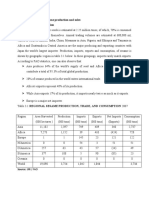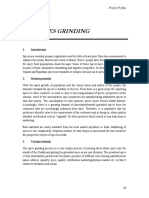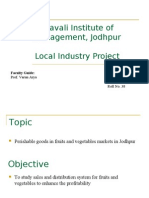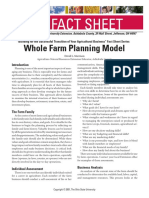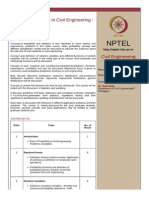Small Farm Decision-Making & Enterprise Planning Workbook: Cooperative Extension
Uploaded by
Trisha BakerSmall Farm Decision-Making & Enterprise Planning Workbook: Cooperative Extension
Uploaded by
Trisha BakerWays to Grow
Small Farm Decision-Making & Enterprise Planning Workbook
NC
COOPERATIVE EXTENSION
STATE UNIVERSITY A&T STATE UNIVERSITY
Helping People Put Knowledge to Work
Prepared by: Judy Green Rural Enterprise Consultants 2247 Mecklenburg Rd. Ithaca, NY 14850 (607) 277-4094
This workbook was originally developed in 1992 for the Small Farm Institute, part of a project funded by the W. K. Kellogg Foundation. For more information on other small farm and direct marketing programs coordinated by the North Carolina A&T State University Cooperative Extension Program, contact:
John O'Sullivan, Farm Management & Marketing Specialist Cooperative Extension Program North Carolina A&T State University PO Box 21928 Greensboro, NC 27420-1928 phone: (336) 334-7956 e-mail: [email protected]
North Carolina Agricultural and Technical State University at Greensboro, North Carolina State University at Raleigh and the U.S. Department of Agriculture cooperating, Greensboro, N.C., D. D. Godfrey, Administrator. Distributed in furtherance of the Food and Agriculture Act, September 29, 1977, PL 95-113, Sec. 1444, as amended. An Equal Opportunity Employer. North Carolina A&T State University is an Equal Opportunity Employer, and does not discriminate against applicants, students or employees based on race, color, national origin, religion, sex, or handicap. Moreover, North Carolina A&T State University is open to people of all races and actively seeks to promote racial integration by recruiting and enrolling a larger number of white students.
Contents
Decision-Making .....................................................................................2 Personal and Family Considerations ...................................................4 Goals and Objectives ..............................................................................8 Know Your Options ...............................................................................10 Planning For Successful Marketing .................................................... 11 Production and Financial Planning....................................................16
Decision-Making: A Textbook Model
1. Set goals
Defining personal and business goals gives you some key guidelines for assessing your options.
2. Identify and analyze your options
Gather information on a range of options, including the market demand, production and labor requirements, start-up and operating costs, and returns of promising enterprises.
3. Select the option that best fits your goals
Sounds simple enough. But have you thought about who ought to be involved in this decision? How you and your family come to this decision can have a profound effect on the success of your business.
4. Make a plan
Writing down your farm business plan helps you to think through all the steps needed to achieve your goals. A good plan will include a goals statement, market assessment and marketing strategy, production plan, labor and management plan (who's in charge of what?), and a careful financial plan with profitability and cash flow projections and loan requirements, if any. This workbook will give you a start on your plan.
5. Implement your plan
This is the fun part the part we usually think of as "farming."
6. Monitor your progress and evaluate your results.
Good record-keeping is a key to good decision-making. After all, the decision-making process is not complete until you've considered the outcome. How are you doing compared to the goals you originally set? Do you need to modify your plans? Taking the time to analyze your records and evaluate the decisions you've made is the way to become a better manager.
Decision-Making: Real Life!
In real life, we seldom do as the textbooks say! Many factors besides pure logic affect our choices. Often we feel too busy to take the time for careful planning and research. And sometimes we simply forget to consider some important issues. Here's a chance to slow down and check where you are in your own decision-making process.
How carefully have you thought about....
Personal and Family Goals Family Labor and Management Resources The Marketplace Give yourself a if you're ahead of the game, a Family Financial Resources if you're okay, or if work needs to be done. Farm Physical Resources
Your New Enterprise's:
Marketing strategy Start-up costs and profit potential Cash-flow patterns Production requirements Labor and management requirements Legal, regulatory and liability issues
Personal and Family Considerations in Starting a New Enterprise
Can you guess what is the most critical factor in the success or failure of every single type of business in the world? Its the Human Factor. But business owners, including farmers, sometimes become so wrapped up in technical problems that they get completely out of touch with the personal issues that can make or break a business. In a family-run business, stresses related to the business carry over directly to the family, and vice-versa.
Have you thought about...
Your personal characteristics as a manager Your level of drive, selfdiscipline, ability to work with people, creativity, decisiveness, and organization will be a key to the success of your new enterprise. Unique needs and perspectives of all participants Everybody sees things differently, and each family member will be affected by the new enterprise, like it or not. Communication In working with family members, with employees, and with customers, how we say it is at least as important as what we say! Teamwork The family in business needs to develop a decisionmaking system that gives everyone a voice and allows conflicts to be resolved.
Reality Check: Is the Rest of the Team Still With You?
It has been shown that in family-run businesses, the principle manager is often a lot more enthusiastic about the business than the rest of the family team. This can really spell trouble. Decision-making in a family business has to take into account the needs and opinions of all family members. How well do you know your team members? Answer the following questions as you think your spouse/partner would, or as your parent, child or significant other would answer. Then make sure you talk about it at home! If youre single, go ahead and fill in your own answers.
Agree Disagree
1. Our family spends too little time together. 2. I really enjoy working hard to make the farm a success. 3. Im very enthusiastic about our new farm enterprise. 4. The farm business is too much for us to handle now. 5. I too often sacrifice the things I like to do for the sake of the farm business. 6. Im not worried about having enough spending money. 7. Being able to work on the farm is more important than having lots of money. 8. The family should always come before the business. 9. I believe we could handle some financial risk with our new enterprise. 10. Its more important for the children to work on the farm than to be involved in a lot of other activities. 11. I feel like my opinions and feelings about the farm business are taken seriously.
Communication: Key to Survival for Business and Family
People see the same situation differently. It's a normal, healthy thing about us human beings. Rather than trying to avoid conflict, we can use conflict in a positive way to strengthen our relationships, and to make better decisions. It's all in the way we communicate with each other. After all, two (or more) heads are better than one!
Negative conflict Provokes hurt feelings, insecurity and distrust of each other; makes us lose self-respect and/or respect for others; makes rational discussions difficult or impossible; wastes time and energy for everyone involved; causes stress and sometimes breakup of relationships.
Positive conflict Helps us understand what others feel is important to them; helps clarify issues, values and choices; clears the air of unspoken disagreements; can result in a new understanding or relationship which brings new energy to the family; can bring a sense of respect to all; and can lead to new or redefined goals which are more satisfactory to everyone.
Making Decisions as a Family
Two Keys to Successful Farm Business Meetings:
1. Participants
Each person involved in a meeting contributes to its success. When each person feels responsible, an effective meeting results. If you expect it to be a waste of time, it probably will be. Participants are responsible to: 1. 2. 3. 4. Be on time. Come prepared with information, concerns, or questions. Listen. Think before reacting. If you have an opinion, voice it, but make sure you're addressing the topic. 5. Accept the group consensus and support it, once a decision is made.
2. Chair, or facilitator
The chairperson sets the tone of the meeting and provides leadership. Sharing leadership at the appropriate times makes the group more effective. The chair is responsible to: 1. Organize the agenda, including suggested time limits. 2. Include everyone in the discussion, encouraging quiet individuals to speak up. 3. Keep discussion on track and within time limits. 4. Help manage conflicts in a positive way. 5. Recognize and encourage individual strengths. 6. Define and assign tasks.
Planning Your Farm Business Meetings
Do you want to discuss: Farm business Who should be involved? Family issues Both
What are the types of issues you most need to discuss with your family?
How should decisions be made? Majority rule Consensus How often should you meet?
Other
Where should you meet? Kitchen table Restaurant In the car ... Other
Farm office
Who would be the best chair to organize and run meetings?
Should this change?
10
Goals and Objectives for Your New Enterprise
What is the single most important goal you and your family hope to achieve by starting this new farm enterprise?
What additional goals do you and your family members have for the enterprise?
What are the most important personal goals of family members over the next three to five years?
List the family members who would like to be actively involved in the new enterprise, and the responsibilities each would like to take on:
If you already run a farm business, what are your goals over the next three to five years for the enterprise you are currently involved in?
Maintain at about the same level Explain: Cut back some. Explain: Get out altogether. Other: Expand
What are your financial goals for this new enterprise? For example, once the enterprise is established, what amount of your family income do you expect from the following sources:
Current farm enterprises New enterprise Off-farm employment Other
Total
11
Know Your Options
Land resources: Buildings available: Machinery and equipment: Water, other resources: Labor available: Special skills:
Local and regional marketing resources:
Farmers markets Restaurants Groceries, specialty stores Ethnic markets Wholesalers Processing plants Slaughterhouses Roadside possibilities Other?
Financial resources for start-up
What are your enterprise options?
Enterprise option Pros Cons
12
Planning for Successful Marketing
How much do you already know about:
Your customers, and how to reach them? Your competition? Your marketing options? Trends in demand, production and prices? Costs of marketing?
Give yourself a if you're ahead of the game, a if you're okay, or if work needs to be done.
Do you know how to find out what you don't already know?
How to do your own market detective work? How to find published market information?
Plan your marketing strategy Do you have the four P's?
A Product that consumers are looking for? A unique Position in the marketplace? An appropriate Price? Effective Promotion?
First rule of marketing: take advantage of all opportunities to get inside your customer's head.
13
Gosh! She's got a lot of reasons for buying from you! .
Understanding Your Customers
A business can't be all things to all people. Choose your "Target Market" carefully.
What do you know about your target market? Answer these questions from your customers' perspective!
How old are we? Where do we live? Where do we work? How much money do we make? Are we married? Single? With kids? Double income? (How busy are we?) What ethnic group? What education level? What about lifestyle? What are our values, wants and needs? What are we looking for in your product?
14
Understanding Your Competition
Determining who your competitors are, the specific types of buyers they serve (their target market), and their competitive strengths and weaknesses will help you define your own position in the marketplace. Your direct competitors are those businesses who are supplying the same types of products as you to the same potential customers. Your indirect competition is any other type of product which customers might buy instead of yours. Make it your business to find out all you can about your direct and indirect competition.
Who Are Your Direct Competitors? What to find out
Competitor A
Competitor B
Competitor C
Business name and location Quality and price of product How much of your product do they sell? Other products and services offered Type of buyer targeted Competitive strengths Competitive weaknesses
What is your indirect competition?
15
Keeping In Touch With Your Market
Effective marketing depends on staying tuned to your local customers and competitors, and also to regional and national consumer trends, industry changes and the economy. Remember - always think like a consumer first, a producer second!
Doing your own market detective work
Visit your competitors and other producers, and talk to suppliers Talk with your current customers survey if needed Visit with wholesale buyers Travel as widely as possible see how people do things elsewhere Visit terminal markets, restaurants, and farmers markets see what is selling Do your own test marketing maybe try a consumer "focus group" Other ideas? Be creative!
Finding published market information
Subscribe to trade and food magazines, association newsletters University and public libraries - ask for help with a computerized search for articles and publications Contact your State Data Center or the US Bureau of the Census, Data User Services Division (301) 763-4100 Try the USDA Economic Research Service (301) 786-1512 Read the popular press and business papers like the Wall Street Journal Contact local planning, business or economic development agencies
16
More Marketing Questions...
As you plan to start a new farm-based business enterprise, you will need to gather additional information for marketing strategies. Here are some important issues to think about, and space for taking notes.
What are your marketing options?
Option 1 Pros Cons
Option 2
Option 3
Others
Information on past and future trends in production, consumer demand, and price for your product?
Ideas for promoting your business?
Other marketing notes (whom to talk to, questions, ideas...)
17
Production and Financial Planning For Your New Enterprise
Before launching your new enterprise, you'll need to gather as much information as you can about production and financial aspects. Below are some questions you will want to think about, and space for jotting down important notes. What capital purchases are required (buildings, improvements, equipment, land, breeding stock...)? Costs?
What legal, regulatory and liability issues might affect your business? How will you deal with them?
What will be your major production and marketing tasks, such as planting and other field operations, harvest, advertising, sales, etc. When should they occur?
AY
JA
FE
JU
For each of these tasks, you will eventually want a good estimate of input requirements and their costs. This will be the beginning of your enterprise budget. Plan to improve your financial management skills. Each of the following is an important tool for business managers. Do you know how to prepare: An enterprise budget to project costs and returns? A cash flow budget showing when to expect expenses and receipts? An income statement to calculate your profit for the year? A balance sheet showing all your assets and liabilities? Ask your Extension agent for help in developing these skills.
JU
You might also like
- Business Plan For Tlotlithlale Auto & Tyre ServicesNo ratings yetBusiness Plan For Tlotlithlale Auto & Tyre Services19 pages
- Entrepreneurship: Writing Business Plans Guideline100% (1)Entrepreneurship: Writing Business Plans Guideline17 pages
- Presentation of Operational: Guidelines For Rkvy-RaftaarNo ratings yetPresentation of Operational: Guidelines For Rkvy-Raftaar17 pages
- 1.urban Farm Business Plan Handbook 091511 508100% (1)1.urban Farm Business Plan Handbook 091511 50877 pages
- 2012-9-17 Guidelines For Import and Export of Foods100% (1)2012-9-17 Guidelines For Import and Export of Foods30 pages
- The New Thinking For Philippine AgricultureNo ratings yetThe New Thinking For Philippine Agriculture21 pages
- Business Plan For Potato Farming - PDF - Manure - Greenhouse100% (1)Business Plan For Potato Farming - PDF - Manure - Greenhouse1 page
- How To Write A Fruit Processing Plant Business Plan100% (1)How To Write A Fruit Processing Plant Business Plan15 pages
- A Project Proposal On, Flower Cultivation in Bangladesh and It's Problems and Prospects.''No ratings yetA Project Proposal On, Flower Cultivation in Bangladesh and It's Problems and Prospects.''8 pages
- Writing Winning Proposals, Giving Winning Pitches: A Second Wind PublicationNo ratings yetWriting Winning Proposals, Giving Winning Pitches: A Second Wind Publication14 pages
- Viability & Economic Preview: Commercial HydroponicsNo ratings yetViability & Economic Preview: Commercial Hydroponics44 pages
- Executive Summary: Example of A 4P Business Plan TemplateNo ratings yetExecutive Summary: Example of A 4P Business Plan Template5 pages
- Executive Summary: Business Plan OutlineNo ratings yetExecutive Summary: Business Plan Outline19 pages
- Value Chain Analysis of Large Cardamom in Taplejung District of NepalNo ratings yetValue Chain Analysis of Large Cardamom in Taplejung District of Nepal19 pages
- USADF-Application - FY22-English (Horn Resin Limited)100% (1)USADF-Application - FY22-English (Horn Resin Limited)11 pages
- Functional Level Strategy: Strategic ManagementNo ratings yetFunctional Level Strategy: Strategic Management26 pages
- Thanks For Downloading This Sample Business: Your Business Is Unique. Your Business Plan Should Be Too100% (1)Thanks For Downloading This Sample Business: Your Business Is Unique. Your Business Plan Should Be Too47 pages
- Sustainable Farming: Small Steps To A Big TomorrowNo ratings yetSustainable Farming: Small Steps To A Big Tomorrow5 pages
- Local Industrial Project On Fruits and Vegetables Market in JodhpurNo ratings yetLocal Industrial Project On Fruits and Vegetables Market in Jodhpur12 pages
- Mulching & Drip Irrigation System Design For Mango Plantation in 1 Acre FieldNo ratings yetMulching & Drip Irrigation System Design For Mango Plantation in 1 Acre Field22 pages
- The Guide To Writing A Business Plan Is Designed To Help New or ExistingNo ratings yetThe Guide To Writing A Business Plan Is Designed To Help New or Existing10 pages
- Business Plan Medicinal-Edit 1-MoontashirNo ratings yetBusiness Plan Medicinal-Edit 1-Moontashir30 pages
- 26-Final Fruit and Forest Plant Nursery Revised 17 FebNo ratings yet26-Final Fruit and Forest Plant Nursery Revised 17 Feb18 pages
- 4th - Ho - Vegetable Seed Production - Abdulqadir-Khdr-BayzNo ratings yet4th - Ho - Vegetable Seed Production - Abdulqadir-Khdr-Bayz14 pages
- From Success To Significance: Never Underestimate The Competition...Tips to Staying RelevantFrom EverandFrom Success To Significance: Never Underestimate The Competition...Tips to Staying RelevantNo ratings yet
- From Successful Business to Personal Financial Security: A Wealth Management Road Map for Entrepreneurs and Their FamiliesFrom EverandFrom Successful Business to Personal Financial Security: A Wealth Management Road Map for Entrepreneurs and Their FamiliesNo ratings yet
- Time To Learn. Understanding Patient Centered CareNo ratings yetTime To Learn. Understanding Patient Centered Care7 pages
- Session 1 - Gender Analysis Concepts and Framework100% (1)Session 1 - Gender Analysis Concepts and Framework86 pages
- Download ebooks file New Instruments of Environmental Governance National Experiences and Prospects Environmental Politics 1st Edition Andrew Jordan all chaptersNo ratings yetDownload ebooks file New Instruments of Environmental Governance National Experiences and Prospects Environmental Politics 1st Edition Andrew Jordan all chapters89 pages
- Poor Reading Comprehension of Grade 10 Students100% (1)Poor Reading Comprehension of Grade 10 Students16 pages
- Nptel: Probability Methods in Civil Engineering - Video CourseNo ratings yetNptel: Probability Methods in Civil Engineering - Video Course2 pages
- The Impact of Mobile Learning On Students' Learning Behaviours and Performance: Report From A Large Blended ClassroomNo ratings yetThe Impact of Mobile Learning On Students' Learning Behaviours and Performance: Report From A Large Blended Classroom23 pages
- Application of Value-Belief-Norm Theory To Responsible Post Consumption Behaviors Recycling and ReuseNo ratings yetApplication of Value-Belief-Norm Theory To Responsible Post Consumption Behaviors Recycling and Reuse13 pages
- AC5002-Management Accounting A21 (1st Sit) CW1 MSNo ratings yetAC5002-Management Accounting A21 (1st Sit) CW1 MS11 pages
- Objectives: Logical Framework Analysis (LFA)No ratings yetObjectives: Logical Framework Analysis (LFA)10 pages
- Jackson, S. a., & Marsh, H. W. (1996). Development and Validation of a Scale to Measure Optimal Experience- The Flow State Scale. Journal of Sport and Exercise Psychology, 18(1), 17–35. Doi-10.1123:Jsep.18.1.17No ratings yetJackson, S. a., & Marsh, H. W. (1996). Development and Validation of a Scale to Measure Optimal Experience- The Flow State Scale. Journal of Sport and Exercise Psychology, 18(1), 17–35. Doi-10.1123:Jsep.18.1.1719 pages
- Department of Geodetic Engineering: Visayas State UniversityNo ratings yetDepartment of Geodetic Engineering: Visayas State University10 pages
- Financial Awareness in Everyday Life Due To The Pandemic, Based On The Results of A Hungarian Questionnaire SurveyNo ratings yetFinancial Awareness in Everyday Life Due To The Pandemic, Based On The Results of A Hungarian Questionnaire Survey13 pages

















